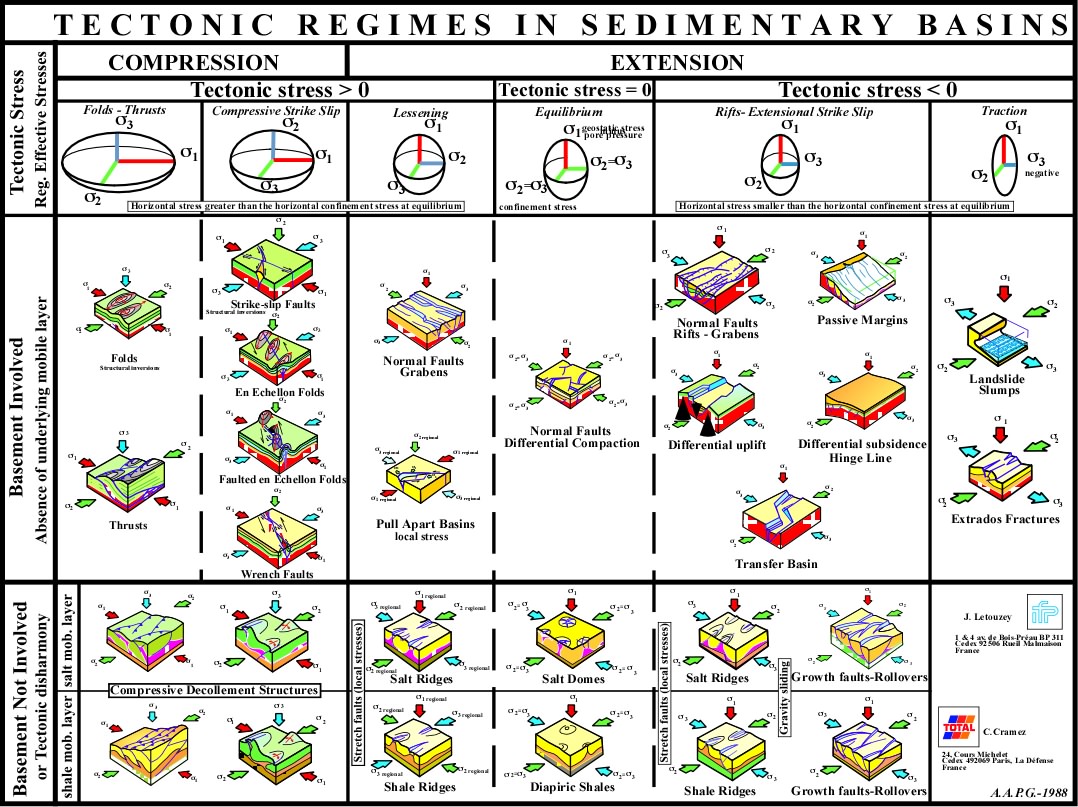
Porto, Portugal

These notes should not be taken as an attempt to write a textbook on Tectonics. They are just an eclectic assemblage of geological models, cross-sections and seismic profiles (geological interpretations) used during my last workshops on Petroleum Geology. The text is reduced to a minimum. On the figures, for confidential reasons, the locations and orientations are not indicated. By the same token, here only the interpretation of the seismic lines are illustrated. The large majority of the figures are personal and falsifiable. Nevertheless, none of them may be used or reproduced in any manner whatsoever without written author's permission (ccramez@compuserve.com) (cramez@ufp.pt).

by
Carlos Cramez & Jean Letouzey
Contents: 1- Mechanical Principles 2- Tectonic General Concept 3- Attempt to Classify Tectonic Regimes 4- Volume Problems 4.1- Scale Problems 4.2- Volume Problems in Compressional Tectonic Regimes (1 horizontal) 4.2.1- Compression-------Shortening-------Uplift-----Erosion 4.2.2- Balanced Structural Interpretation 4.2.3- Depth to Detachment 4.2.4- Limitations of Depth to Detachment Calculations 4.2.5- Volume Conservation 4.2.6- Kink Method 4.2.7- Kink Software 4.2.8- Fault Propagation 4.2.9- Fault-bend Fold 4.2.10- Kink Method in Seismic Sections 4.3- Volume Problems in Extensional Regimes (
l vertical) 4.3.1- Extension---Subsidence---RSL Rise---Sedimentation 4.3.2- Detachment Surface 4.3.3- Normal Faults & Volume Problems 4.3.4- Fault Curvature with Depth 4.3.5- Fault Geometry 4.3.6- Graphic Construction of Depth Fault 4.3.7- Fault Terminology 4.3.8- Development of Hangingwall Syncline 4.3.9- Fault Intersection on Maps and Seismic Sections 5- Tectonic Regimes in Sedimentary Basins 5.1- Basement Involved 5.1.1- Compression (
1 horizontal) 5.1.1.1- Folds & Thrusts A- Folds B- Reverse Faults C- Thrust Belts 5.1.1.2- Compressive Strike-Slip A- Small horizontal displacement (1-5 km) B- Medium horizontal displacement (5-20 km) C- Large horizontal displacement (20 km) 5.1.2- Extension (
1 vertical) Generalities a) Sequence of geological events b) Dip of beds and dip of faults c) Angle between the fault plane and the vertical d) Depth of a detachment surface e) Amount of extension f) Ends of a normal fault g) Normal faulting deformation h) Intermediated fault blocks i) No planar faults j) Deformations in no planar faults k) Associated grabens 5.1.2.1- Positive Tectonic Stress
t > 0 a) Normal Faults - Grabens b) Pull-apart Basins (Local stresses) 5.1.2.2- No Tectonic Stress (
t = 0) 5.1.2.3- Negative Tectonic Stress (
t < 0) a) Rift-type basins & Grabens b) Continental margins divergent c) Differential subsidence d) Differential uplift e) Transfer basins 5.2- Basement not Involved 5.2.1- Evaporitic mobile substratum 5.2.1.1- Compressive décollement structures 5.2.1.2- Extensive salt structures 5.2.1.2.a- Basic Principles in Salt Tectonics 5.2.1.2.b- Origin of a dome 5.2.1.2.c- Evolution of dome's flanks 5.2.1.2.d- Faults associated with domes A) Stretch faults B) Growth faults 5.2.1.2.e- Evolution domes and residual structures (i) Structural changes in the salt A. Mature domes B. Bottom pinchoff C. Overhang (ii) Structural changes in sediments a) Collapses b) Turtle structures c) Haggis structures d) Raft Tectonics 5.2.1.2.f- Review of salt dome growth A) Mounded Stage B) Dome Stage C) Post-dome Stage 5.2.1.2.g- Potential reservoirs and traps 5.2.1.2.h- Post-sedimentary halokinetic movements 5.2.2- Shaly mobile substratum A) Compressional structures B) Extensional structures B.1- Plasticity B.2- Undercompaction B.3- Fault displacement B.4- Fault associated with shale tectonics B.5- Growth fault displacements B.6- Growth faults and traps 5.3- Surface Phenomena 5.3.1 - Landslide and Extrados Fractures 5.3.2- Folds and Faults associated with Gravity
to continue press
next
Send E-mail to ccramez@compuserve.com or cramez@ufp.pt with questions and comments about these notes.
Copyright © 2001 CCramez
Last update: March, 2006